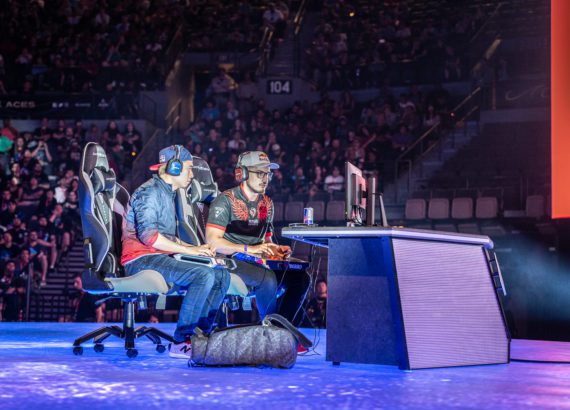From Fortnite concerts to politicians campaigning in video games, there’s always something new in the world of gaming. Now, games are developed with spectators, not just the players, in mind.
It’s all thanks to the esports boom.
Esports, also known as electronic sports, are video game competitions that are taking the world by storm. Though these competitions aren’t anything new, it is the rise of the streaming platform that has helped esports gain massive popularity.
Today, esports are beginning to displace even traditional sports among Gen Z (born between 1997-2012), including the MLB, NASCAR, and the NHL. As this generation grows up, viewership is increasing year over year, with 646 million viewers expected by 2023. People even play fantasy esports leagues, and we may see esports at the 2024 Olympics. Add in eye-popping cash prize pools for tournaments (think $34 million dollars), and it’s no wonder that people are starting to pay attention to esports.
So, what are esports?
The digital sports phenomena began in South Korea with an explosion of LAN gaming centers, known as PC bangs. These gaming hubs offered super-fast internet and top-notch gaming computers. People gathered at PC bangs to play video games, which eventually transformed into competitive tournaments. Television networks also began to cover the competitions, helping to grow interest.
It was streaming platforms like YouTube and Twitch that began delivering esports to the masses. The latter regularly streams esports competitions, making it easy to view from anywhere in the world. Esports streams are often free too, making them more accessible than other sports might be.
Now, esports is a complex organization of gamers, teams, and sponsors built around huge international tournaments.

Ok…but is playing video games really a sport?
Sports of all kinds require different levels of physicality. For example, motorsports have different requirements than American football, but both are sports. There are many sports that are less physically taxing than others but still need precision and skill like the Olympic sport of shooting.
Esports can definitely be considered a sport. They require fine motor skills, precision, hand-eye coordination, strategy, and team management and participation. Gamers also practice and may have a coach to help them improve. Esports players even maintain a gym routine to stay fit enough to compete.
Physicality aside, there is also the demand and interest from spectators.
What are the biggest games in esports?
While all esports games are video games, there are plenty of video games that will never make the cut as an esport. Games that use strategy, long-term planning, teamwork, dexterity, and skill can find a place in esports.
The most popular esports games are multiplayer online battle arena (MOBA), first-person shooters (FPS), real-time strategy (RTS), battle royale, and traditional sports games.
MOBAs
Think of these games as a digital capture the flag. MOBAs first began as a modded version of StarCraft, the OG esports game. Players choose champions/characters and break into teams with the goal of destroying the enemy base. Different champions usually have different abilities, like attacking, defending, or healing. League of Legends and DOTA 2 are two of the most popular MOBAs today.
FPS
In a first-person shooter game, like Valorant, Call of Duty, Counter-Strike Global Offensive, and Overwatch, you play as one character with a weapon. Often, your goal is to eliminate the other players, achieve objectives, and be the winner in the field. In games like Overwatch, you’ll act as part of a team, working together to achieve objectives. With first-person shooter games, you need dexterity and quickness to pull the trigger, as well as strategy and stealth skills to be the last one standing.
RTS
Real-time strategy games like StarCraft: Brood War and Warcraft III helped launch esports. In RTS games, players start out in areas of a gameplay map and must build up their base, resources, and armies to defeat their competition.
Battle royale games
If MOBAs are digital capture the flag, a battle royale game is The Hunger Games. Up to a hundred players are all put into the game space and must battle it out to be the last one standing. Players can team up and play in groups or try to survive on their own. Usually, you’ll only have one life – so you need to make it count. The Fortnite Battle Royale is one of the most popular esports games today and is free, so anyone can play.
Traditional sports
Basketball, soccer, and racing all have digital competitions in the esports world. Some of the major sports organizations are creating their own digital leagues too.
Why people like to watch esports.
Like any sport, being good at video games comes down to talent and skill. People often watch esports and gaming influencers play games online to get tips, tricks, and advice from a professional.
Esports gamers are also accessible to their fans. Since many of them stream on Twitch or have YouTube channels, fans have much more access than they might to a famous basketball player. Fans can regularly interact with their favorite players, get notified when streamers go online, and chat with other fans and the players themselves. In short, it’s like a high school football player having access to someone like Tom Brady any time they want to ask him questions or watch him practice.

Esports leagues, teams, and tournaments.
Esports leagues are specific to a video game, like League of Legends or Call of Duty, and leagues may take place regionally or internationally. Major esports organizations, like the Electronic Sports League (ESL), help organize gaming competitions all over the world.
Teams participate in the leagues and compete in tournaments. Depending on the game, a team will have a few roster positions to fill. Some of the roster positions are dedicated to specific roles, like scouting the enemy’s base, or healing fellow team members. Teams may also have coaches and practice sessions.
Tournaments are often hosted by third-parties or game developers. Like leagues, these competitions are for specific games. Open tournaments mean anyone can enter, provided they meet qualification standards, while an invitational is reserved for select players. Round one of the tournaments starts with a group stage, which may be a round-robin, a double round-robin, or Swiss seeding. From there, it goes to a bracket-style tournament, which may be single or double elimination.
From there, the (often massive) prize pools are split according to ranks in the tournament, with the winning team taking home the biggest percentage.
How do esports make money?
Most of the money in esports comes from sponsorships from major companies like Microsoft, Red Bull, and Samsung. But there is also money in merchandising, media rights, and ticket sales for live events. Revenues for esports are expected to reach $1.8 billion by 2022.
The gamers themselves stand to make millions in competitions. But they can also merchandise and take on influencer sponsorships. Some even earn big paychecks from streaming live on Twitch. Ninja, for example, makes approximately $500k a month through streaming.
Last words.
Esports is an industry that is gaining momentum and evolving all the time.
Interested in getting into esports? You’re going to need internet with unlimited potential. Quantum Fiber is proud to offer a fiber optic network with speeds up to 940 Mbps, 99.9%* reliability, and symmetrical upload and download speeds. Check to see if our game-changing fiber internet is available near you today.
* Based on network uptime or availability.
Although our fiber service usually means 100% fiber-optic network to your location, in limited circumstances Quantum Fiber may need to deploy alternative technologies coupled with a non-fiber connection from a certain point (usually the curb) to your location in order to provide the advertised download speeds.








